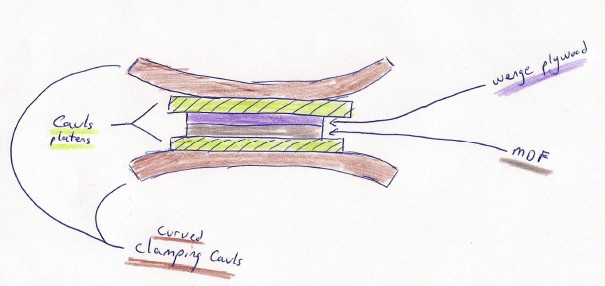Adhesives and Gluing Methods for Cutting Boards
A craftsman finds that his cutting boards are cracking at the joints. Was it the glue he chose, or the way he applied it? October 2, 2005
Question
I'm a career cabinetmaker, trying my hand at smaller projects at my customers' request. My latest venture has been into the realm of cutting boards. I recently glued up some scrap sticks (jointed) of hard maple, using polyethylene glue. Despite the claim that the glue is waterproof, the boards cracked and split, sometimes violently, within a week. Am I using the wrong adhesive?
Forum Responses
(Adhesives Forum)
From Gene Wengert, forum technical advisor, Sawing and Drying Forum:
Did the pieces crack in the wood or at the joint? If at the joint, how much time was there between preparing the surfaces and applying the pressure? What machine was used to prepare the surfaces prior to gluing, and how much pressure was used?
From the original questioner:
The board cracked at the joints. I jointed the surfaces immediately prior to gluing and clamping. I used a grizzly brand jointer. I used 3/4" and 1" pipe clamps, clamping tightly overnight. The joints appeared to be tight, adding to my confusion.
From contributor A:
I've glued up boards using yellow glue and plastic resin glue with no problems. I'm not familiar with the brew you used but if it was yellow or plastic resin, I'd say you clamped it too tight.
From the original questioner:
That is interesting. I've never had a problem clamping too tightly. In fact, I didn't know it was possible to clamp too tightly with hand-operated clamps. My thought was that the glue failed under the tension of the wood, which was intensified by being wet and dry. So I should try again with less clamping tension?
From contributor B:
You can clamp your joints too tightly, squeezing too much glue from the joint, starving the joint and not leaving enough glue for the holding power. Clamps should only be tightened so a small amount of glue is pressed out the edges and joint looks tight.
From contributor C:
What is polyethylene glue? I'll also ask the obvious - are you sealing the boards with mineral oil, Walnut oil or other food safe sealing product? Are the boards soaked in water or run thru the dishwasher?
From the original questioner:
I was mistaken about the glue - it's polyurethane glue, Elmer's brand. The boards were finished with mineral oil, which doesn't exactly seal the wood from water, even after multiple applications. The boards were never put in a dishwasher, or even soaked in water- just rinsed off and set in a dish rack. Could my choice of finishing oil cause this?
From Gene Wengert, forum technical advisor, Sawing and Drying Forum:
There is no question that wetting the boards causes the wood to swell (or try to swell) and this results in tremendous pressure on the wood, especially at the ends where water can move quickly into the end grain. The panel will break at the weakest link, which in your case is the glue joint. Is this breaking point a result of a weak adhesive inherently? Probably not, but check with the manufacturer. Is it the result of poor gluing practices? Probably. Is it a weakening of the adhesive by the water? Not likely.
I recall a posting in the past that said a wooden bowl manufacturer glued up bowls with PUR and ran them through a dishwasher 100 times without a problem. Check the WoodWeb archives.
From the original questioner:
I chose the polyurethane glue because it claims to be waterproof. I did clamp the boards very tightly, and I'm sure now that I ended up starving the joints.
From contributor C:
Mineral oil will not cause the joints to fail. It is a good a food safe strategy for sealing the boards. Walnut oil will not go rancid, and it is available in the health foods section of large grocers. It does sound like you starved the joints. I use a lot of PUR, but have found strong differences from one brand to another. I now use West epoxy on the few boards I make. It does not require lots of pressure, bonds like crazy and is more waterproof than the PUR. The more visible glue line is disguised by a contrasting strip of another species. The less exposure to water, the better. After sanding, keep the board wet with oil for 3-4 days, then clean off excess. Rinse it off, towel dry, and keep the end grain from sitting in any water. Re-oil as needed.
From contributor D:
I am from Casco Adhesives, living in Singapore. We also make cutting boards in Asia. The glue we are using is EPI. There are two tests we are doing for the bonding strength - Climate cycles test and Water soaking test. For Climate Test, we keep the glued piece at 20 degrees C for 2 hours then put at 50 degrees C for 2 hours. 5 cycles are needed. For water soaking test, we put the glued piece in cold water for 6 hours, the dry it at 40 degrees C for 18 hours. If the glued piece can pass both tests, then there will be no problem of delamination. My suggestion is to try EPI. Be careful - not all EPI can pass these two tests.
From Gene Wengert, forum technical advisor, Sawing and Drying Forum:
For everyone's information: Emulsion Polymer Isocyanate (EPI) adhesives are two-component adhesives based on reaction of a mixture of water based emulsions of SBR, EVA and PVAc type with an isocyanate hardener (crosslinker) forming water-resistant bonds. It is not waterproof. The tests above mentioned by contributor D are fairly mild compared to putting the wood in a dishwasher.
